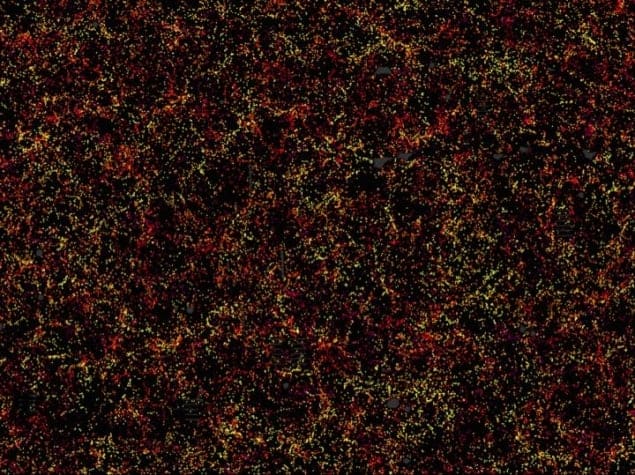
Astronomers working on the Baryon Oscillation Spectroscopic Survey (BOSS) have analysed data from 1.2 million distant galaxies to gain further insights into the evolution of the universe. Acquired by the Sloan Digital Sky Survey III (SDSS-III) telescope in New Mexico, the data have been used to create the best map yet of baryon acoustic oscillations (BAOs). These are the relics of the early universe that chart-out how it has expanded over the past 13 billion years.
The BAO map is consistent with the current “Lambda-CDM” model of the universe, which incorporates dark energy and dark matter. Analysis of the data also shows that Einstein’s general theory of relativity is correct at cosmological length scales.
BAOs were created when the universe was just 400,000 years old and the first atoms were forming. Light and matter in the universe decoupled in this epoch, with the light forming the cosmic microwave background (CMB) that is still visible today. When the matter decoupled, its spatial distribution was defined by the peaks and troughs of pressure waves that had existed throughout the universe. This distinct pattern of matter density – the BAOs – then began to evolve into a universe of stars and galaxies. Thanks to theoretical calculations and information gleaned from the CMB, astronomers have a very good idea of what the BAOs looked like in the early universe.
Galaxies and voids
As the universe expanded over the next 13 billion years, gravity pulled matter into regions of higher density to form galaxies, while regions of lower density became voids in space. This pattern of galaxies and voids resembles the early BAOs, with one crucial exception – the characteristic distances between galaxies and voids have increased greatly as the universe expanded. So by mapping the BAOs as a function of cosmic time, astronomers can chart the expansion of the universe over billions of years.
In this latest development, BOSS astronomers have mapped out the BAOs in great detail from 7 billion to 2 billion years ago. They did this by observing 1.2 million galaxies over one quarter of the sky. The distance to each galaxy – and hence the time at which its light began the journey to Earth – was worked out by observing the redshift of characteristic atomic emission and absorption lines in the spectrum of light from that galaxy.
The standard model of cosmology is called “Lambda-CDM”, and it suggests that the expansion of the universe is governed by two competing agents. The gravitational tug of dark matter – which is about 85% of the matter in the universe – acts as a restoring force that tends to work against the expansion. On the other hand, dark energy – which appears to account for 70% of the energy in the universe – pushes in the opposite direction and is currently accelerating the expansion of the universe.
“Clean cosmological picture”
Dark energy does not appear to have played a role in the early universe, and seems to have kicked-in about 5 billion years ago, which is why BOSS was designed to study the BAOs over that time period. This latest study provides further evidence for Lambda-CDM, with an error of only 5% between the measured and theoretical value of the cosmological constant that describes dark energy. “Our latest results tie into a clean cosmological picture, giving strength to the standard cosmological model that has emerged over the last 18 years,” says BOSS team-member Jose Vazquez of Brookhaven National Laboratory.
To create an accurate map, the team had to contend with the “peculiar motions” of galaxies, which refers to the movement of a galaxy that is not related to the expansion of the universe. This appears in the BAO map as an anisotropy that must be corrected for. This peculiar motion is caused by gravity working over huge distances in the universe and analysis of the anisotropy allowed the BOSS team to show that Einstein’s theory of gravity – his general theory of relativity – is correct over very large distances.
The research is described in a series of papers in the Monthly Notices of the Royal Astronomical Society.



